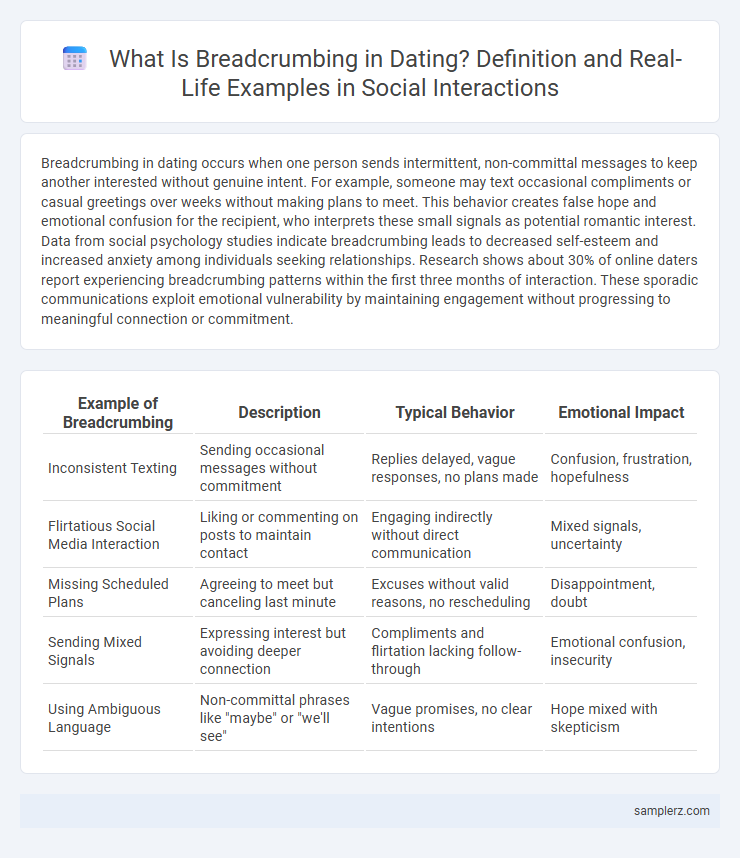Breadcrumbing in dating occurs when one person sends intermittent, non-committal messages to keep another interested without genuine intent. For example, someone may text occasional compliments or casual greetings over weeks without making plans to meet. This behavior creates false hope and emotional confusion for the recipient, who interprets these small signals as potential romantic interest. Data from social psychology studies indicate breadcrumbing leads to decreased self-esteem and increased anxiety among individuals seeking relationships. Research shows about 30% of online daters report experiencing breadcrumbing patterns within the first three months of interaction. These sporadic communications exploit emotional vulnerability by maintaining engagement without progressing to meaningful connection or commitment.
Table of Comparison
| Example of Breadcrumbing | Description | Typical Behavior | Emotional Impact |
|---|---|---|---|
| Inconsistent Texting | Sending occasional messages without commitment | Replies delayed, vague responses, no plans made | Confusion, frustration, hopefulness |
| Flirtatious Social Media Interaction | Liking or commenting on posts to maintain contact | Engaging indirectly without direct communication | Mixed signals, uncertainty |
| Missing Scheduled Plans | Agreeing to meet but canceling last minute | Excuses without valid reasons, no rescheduling | Disappointment, doubt |
| Sending Mixed Signals | Expressing interest but avoiding deeper connection | Compliments and flirtation lacking follow-through | Emotional confusion, insecurity |
| Using Ambiguous Language | Non-committal phrases like "maybe" or "we'll see" | Vague promises, no clear intentions | Hope mixed with skepticism |
Recognizing Breadcrumbing: Common Behaviors in Modern Dating
Breadcrumbing in modern dating often involves sporadic messages that spark interest but lack commitment, such as occasional texts or likes on social media without follow-up plans. Individuals engaging in breadcrumbing may avoid deep conversations or clear expressions of intent, creating confusion about the relationship's status. Recognizing these patterns--mixed signals, delayed responses, and vague promises--helps individuals protect their emotional well-being and set healthier boundaries.
Texting Tricks: How Breadcrumbing Shows Up in Messages
Breadcrumbing in dating often appears through sporadic and noncommittal texts that create false hope, such as vague compliments or intermittent "Hey, how are you?" messages without follow-up plans. These texting tricks keep the receiver emotionally invested while avoiding genuine connection or clear intentions. The pattern exploits digital communication to maintain interest without commitment, leaving the recipient confused and waiting for more consistent interaction.
Social Media Signals: Digital Breadcrumbing Examples
Digital breadcrumbing in dating often appears through inconsistent or ambiguous social media signals, such as liking a crush's posts without initiating direct conversations or frequently viewing their stories without responding. These actions create a false sense of interest and connection, leaving the recipient uncertain about the sender's true intentions. Such patterns exploit the visibility and immediacy of social media interactions to maintain attention without commitment.
Mixed Signals: When Communication Feels Inconsistent
Breadcrumbing in dating often manifests through mixed signals, where one person sends sporadic messages that are affectionate yet vague, creating uncertainty. These inconsistent communications prevent clarity about the relationship's status, keeping the other party emotionally engaged without commitment. This pattern undermines trust and can lead to confusion and frustration in romantic interactions.
Flirtation Without Follow-Through: Leading Without Intention
Breadcrumbing in dating often appears as flirtation without follow-through, where one partner sends intermittent messages or compliments to maintain interest without genuine intent. This behavior manipulates emotions by creating false hope and prolonging uncertainty. Typical signs include sporadic texts, vague plans, and avoidance of commitment despite apparent enthusiasm.
Making Plans That Never Happen: The Promise Trap
Breadcrumbing in dating often manifests through making elaborate plans that consistently fall through, creating a cycle of anticipation and disappointment. This "promise trap" manipulates emotions by fostering false hope without genuine commitment, leading to confusion and emotional exhaustion. Recognizing these patterns is crucial for maintaining healthy boundaries and avoiding repeated emotional investment in unfulfilling interactions.
Keeping You on the Back Burner: Breadcrumbing in Casual Relationships
Breadcrumbing in casual relationships often involves sending intermittent, non-committal messages or flirtatious hints that keep someone emotionally interested without any intention of deepening the connection. This tactic keeps the person on the back burner, maintaining their attention while the breadcrumbing individual explores other options or avoids commitment. Common examples include sporadic texts, vague plans, or compliments that signal interest but never lead to meaningful interactions or exclusivity.
Emotional Manipulation: Subtle Breadcrumbing Tactics
Breadcrumbing in dating often involves subtle emotional manipulation, such as sending sporadic messages to maintain interest without commitment. These tactics exploit a person's hope for a relationship by offering just enough attention to keep them emotionally invested. This inconsistent engagement fosters confusion and dependency, making it difficult for the recipient to move on.
Ghosting vs. Breadcrumbing: Spotting the Difference
Ghosting occurs when one partner abruptly cuts off all communication without explanation, leaving the other person confused and seeking closure. Breadcrumbing, by contrast, involves sending intermittent, non-committal messages or signals to keep someone's interest alive without genuine intent to pursue a relationship. Recognizing breadcrumbing demands attention to inconsistent engagement and vague promises, whereas ghosting is marked by total and sudden disappearance.
Protecting Yourself: Responding to Breadcrumbing in Dating
When recognizing breadcrumbing in dating, maintain clear boundaries by limiting emotional investment and communication with individuals who send inconsistent signals. Prioritize self-respect by addressing vague or non-committal messages directly and seeking clarity about intentions. Utilize support from trusted friends or counselors to reinforce confidence and avoid falling into manipulation or prolonged uncertainty.

example of breadcrumbing in dating Infographic
 samplerz.com
samplerz.com